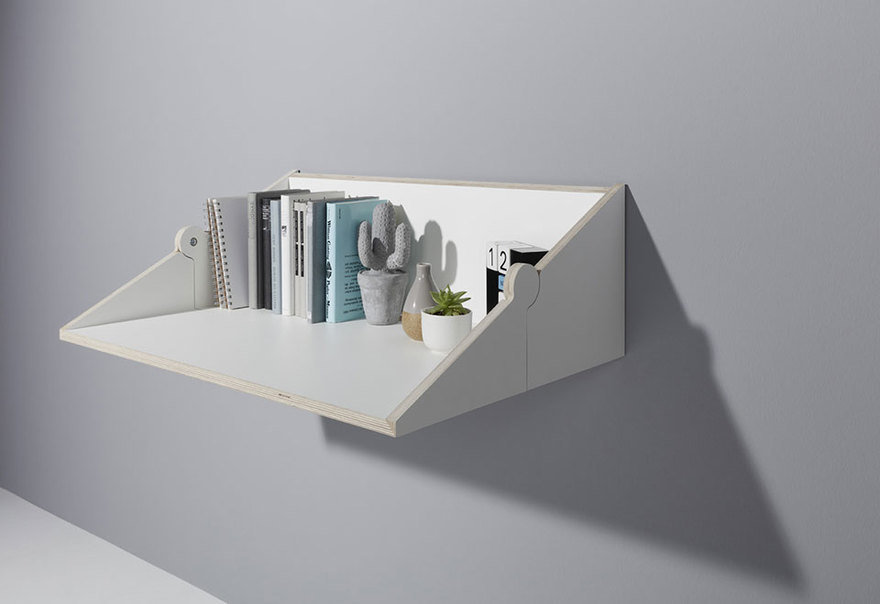Yea or Nay: Are These "Space-Saving" Transforming Furniture Designs Valid, or Do They Miss the Point?
Here are two pieces of furniture that transform, and that don't make any sense to me. First up the Twofold:
 Enter a caption (optional)
Enter a caption (optional) Enter a caption (optional)
Enter a caption (optional) Enter a caption (optional)
Enter a caption (optional) Enter a caption (optional)
Enter a caption (optional)Okay, so it's supposed to be a wall shelf that can turn into a desk. But as you can see, it's not deep enough to hold a laptop unless you first remove the items that were calling the object home when it's in shelf mode. So what are you supposed to do with those things, put them on the floor every time you want desk mode, then pick them up and put them back when you're done? To me this succeeds as a desk or as a shelf, but not both.
Secondly is this dining table that turns into a bookcase:
Again, same problem: So when you want to eat dinner, you clear all the books off of the shelves and place them elsewhere, then slide this thing away from the wall? Then when you're done, you clean the table, push it back up against the wall and re-load it? And actually, looking at the splay of the base, you can't get this thing up against a wall. The footprint is significantly larger than the bookshelves themselves ought occupy. So to me this succeeds as a table (for two, anyway, the base makes legroom for more people awkward) but fails as a bookcase.
In my mind, transforming furniture makes sense when each of the two tasks the thing is meant to perform are temporary. As an example, a sofa that turns into a bed makes sense. You have a dedicated time for sleeping, during which time you don't need a sofa, and a dedicated time for lounging on a sofa when you don't need a bed. But books on a shelf are permanent in most people's homes. If you're going to eat or work, the need for the books to have someplace to sit doesn't disappear.
What are your thoughts?
-
oFavorite This
-
Q9Comment
K
{Welcome
Create a Core77 Account
Already have an account? Sign In
By creating a Core77 account you confirm that you accept the Terms of Use
K
Reset Password
Please enter your email and we will send an email to reset your password.


Comments
I saw, and defended, this bookshelf/table a few months ago. For an open floor plan or studio space, this is a decent idea. It could be used as a room divider when it's closed, and not take up much space until it's opened as a table. If you use the bookshelf to house all the items you'd use for dinner- plates, utensils, cups, linens, serving bowls, it wouldn't require moving things on and off the shelf to use the table, assuming this table IS used as a dining table and not an all purpose desk/table.
can't get past the turntable "needle drop" in the video to even form an opinion on the convertible table. BRUTAL.
I think context is crucial here. Where are they situated, who is using them and in what spaces - this alone could void or justify these designs. I think there is also is something to be said about designers often been so focused to conceive something that 'does' something, that they miss the 'why'. Not saying either of these designs fall victim to this just a possibility.
Works okay if one use is infrequent enough. I could see the bookcase working for hosting occasional guests, can't see the shelf-desk working so well though.
Yea on the shelf implementation of a space saving concept.
"Your scientists were so preoccupied with whether or not they could, they didn't stop to think if they should."
So it needs a Smart Screen is what you're saying?
The top shelf pictured would be useful, slightly larger, to hold binders and other notebooks. This way, you could open 'er up and add/remove pages right there at the shelf, without having to deploy the whole thing to the nearest table and take up valuable desk space. Not everyone works this way, of course, but I am a 3-ring binder kinda person, so this would be nice for me.
The first one I very much agree. Also it's just a very low shelf. It seems the easier solution is just to have a full desk there. The obvious problem is you can't really use the top as you'd need to always take things down. That design seems more appropriate for a feature that extends to create the desk portion.